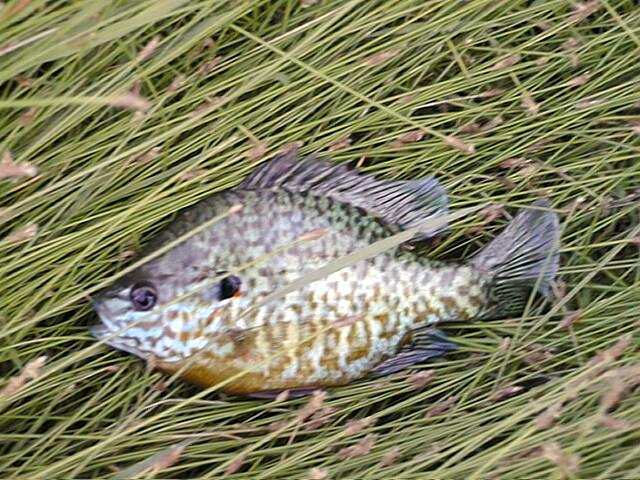Name/Relations || Range/Sizes || Habitat & Habits || Notes
 |
|
Common Name:
Pumpkinseed Sunfish
Other Common Names:
sunfish, perch, sun perch
Scientific name:
Lepomis gibbosus
Family:
Sunfishes (Centrarchidae)
Related Species:
Green Sunfish, Longear Sunfish, Orangspotted Sunfish, Bluegill
| Range: Northern U.S. (Mississippi River Basin and Northern Appalachians) |
Sizes: up to 1 pound, though most commonly 3"-6"
Habitat: Cool, clear, spring fed lakes, ponds, and streams, prefers 55-75 degree water. It will seek out springs and small, clear, gravelly, feeder creeks of lakes and resevoirs.
Spawning Habits: Spawning begins after the water has reached 60-70 degrees, in the spring or early summer, and can continue for a month or more. Themale constructs a dish shaped nest (12-15" in diameter) in pea sized to 1" diameter gravel, usually near the nests of other males. The femalechooses a nest, the male entices her in, and she mates with the resident male. Multiple females may visit each nest. The male will then guard the nest very aggressively until the eggs hatch. Prefers to spawn in areas with light current.
Feeding Habits: Largely zooplankton and rotifers in smaller specimens. Larger fish also consume nymphs, small insects, scuds, freshwater shrimps, small molluscs (snails, baby mussels), minnow fry, and worms.
Notes:
Commonly hybridizes with other sunfish, though this sunfish is an excellent
indicator of water cleanliness and health. Very susceptable to siltation
and pollution, and as such has lost range from deforestation, runoff, and
sewage. A small bait eater, it can be very aggressive in streams
and in clear water and will readily take very small jigs and a variety
of size #16-#10 flies, both wet and dry. It will also fall for small
earthworms (red wigglers), maggots, crickets, and mealworms if fished on
small hooks and light line (2lb test, #10 hook). A forage species
for large brown trout, pikes, flathead catfish, and smallmouth bass.